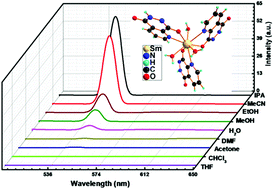A series of mononuclear lanthanide complexes featuring 3-D supramolecular networks: synthesis, characterization and luminescent properties for sensing guest molecules†
Abstract
A new series of four isostructural mononuclear lanthanide complexes Ln(HPDH)3(H2O)3·H2O (Ln = Sm(III) 1, Eu(III) 2, Tb(III) 3 and Dy(III) 4; H2PDH = 6,7-dihydropyrido(2,3-d)pyridazine-5,8-dione) has been prepared and characterized by IR, elemental analysis, XRD and TG-DTA methods. Single crystal X-ray diffraction analysis of both complexes 1 and 3 revealed that the mononuclear discrete complexes form 3-D supramolecular networks via hydrogen bonds and offset stacking (–H⋯π) interactions. The photoluminescence study of the title complexes revealed the photoluminescent potential of the antenna ligand (H2PDH) toward the concerned lanthanide cations. The luminescence based sensing ability of the partially dehydrated complex Tb(HPDH)3(H2O)33a towards small solvent molecules, along with its reusability, has been studied. Isopropyl alcohol was found to be an excellent sensitizer, while tetrahydrofuran was a highly quenching solvent with a first order behavior towards the photoluminescence intensity. The photoluminescence intensity was found to decrease with the increase of the dielectric constant and normalized Dimroth–Reichardt ET parameter values for protic solvents, while reverse behavior was observed for dipolar aprotic solvents.


 Please wait while we load your content...
Please wait while we load your content...